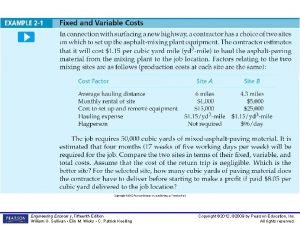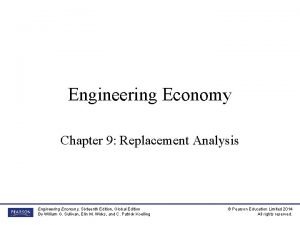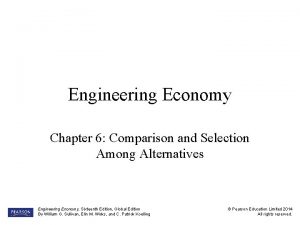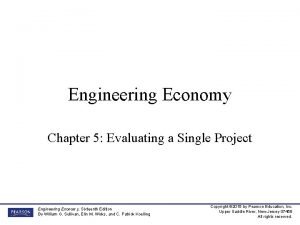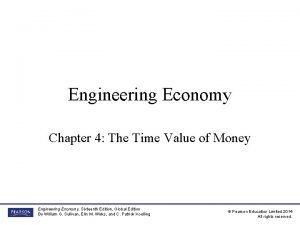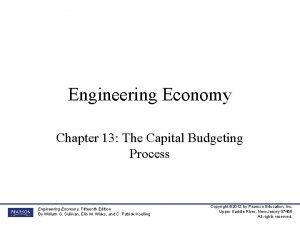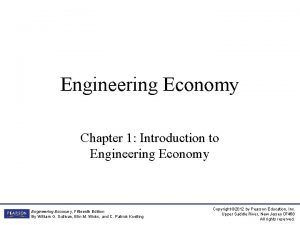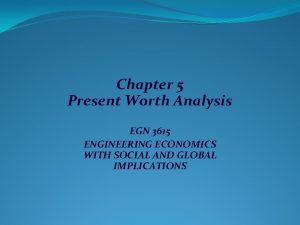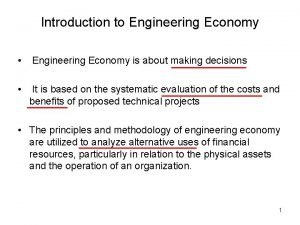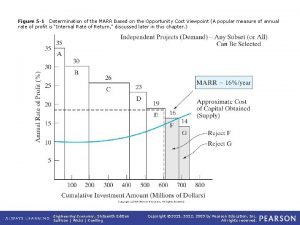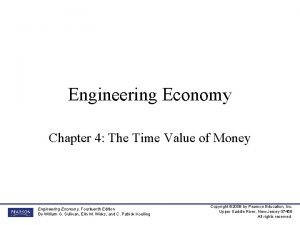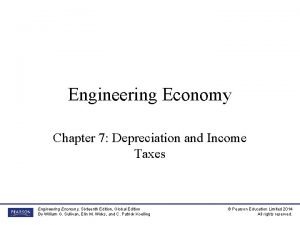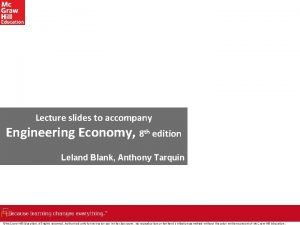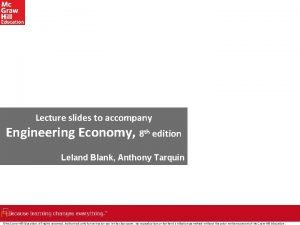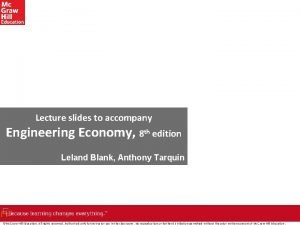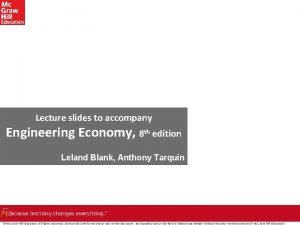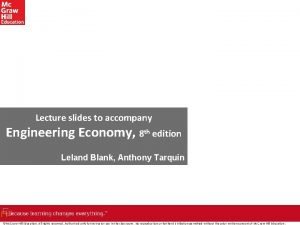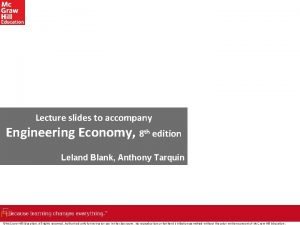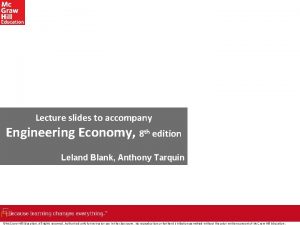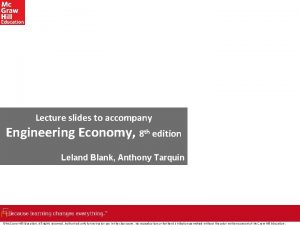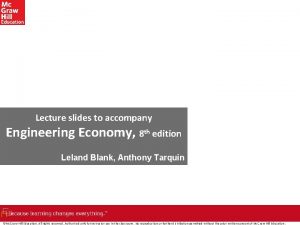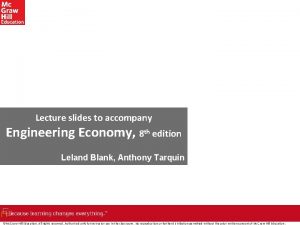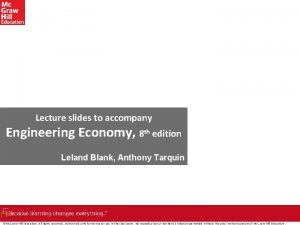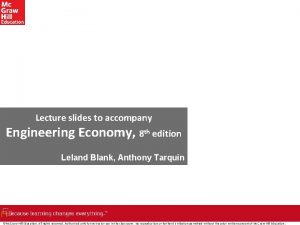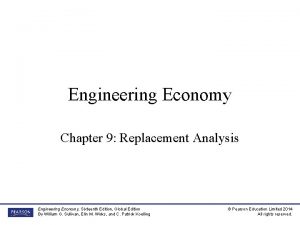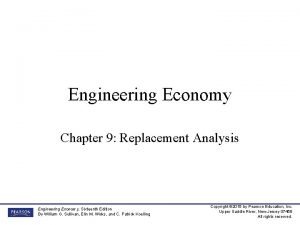Lecture slides to accompany Engineering Economy 8 th























- Slides: 23

Lecture slides to accompany Engineering Economy, 8 th edition Leland Blank, Anthony Tarquin ©Mc. Graw-Hill Education. All rights reserved. Authorized only for instructor use in the classroom. No reproduction or further distribution permitted without the prior written consent of Mc. Graw-Hill Education.

Chapter 10 Project Financing and Non. Economic Attributes ©Mc. Graw-Hill Education. All rights reserved. Authorized only for instructor use in the classroom. No reproduction or further distribution permitted without the prior written consent of Mc. Graw-Hill Education.

LEARNING OUTCOMES 1. Explain cost of capital and MARR 2. Calculate weighted average cost of capital 3. Estimate cost of debt capital 4. Estimate cost of equity capital 5. Understand high D-E mix and risk 6. Develop weights for multiple attributes 7. Apply weighted attribute method to alternative evaluations ©Mc. Graw-Hill Education.

Cost of Capital and MARR Cost of capital is the weighted average interest rate paid based on debt and equity sources Debt capital represents borrowing outside company Equity capital is from owners’ funds and retained earnings MARR is set relative to cost of capital ©Mc. Graw-Hill Education.

Factors Affecting MARR Project risk: higher risk leads to higher MARR Investment opportunity: in order to capture perceived opportunity, MARR lowered may be temporarily Government intervention: gov’t actions such as tariffs, subsidies, etc. companies to raise or lower MARR can cause Tax structure: rising corporate tax rates lead to higher MARR Limited capital: as capital becomes limited, MARR increases Rates at other corporations: competition cause companies to raise MARR ©Mc. Graw-Hill Education. or lower

D-E Mix and Weighted Average COC Debt-to equity (D-E) mix identifies percentages of debt and equity financing for a corporation • This figure Illustrates WACC If the percentage of equity capital from each source is known, each component of WACC is separately calculated ©Mc. Graw-Hill Education.

Example: WACC Calculation A company that specializes in producing cold-weather clothing and accessories is expanding its ski-jacket and bootsock manufacturing facilities. The company plans to borrow $2. 5 million at 7% interest, issue stock worth $4 million worth at 5. 9%, and use $1. 5 million of retained earnings at 5. 1% to finance the project. Determine the company’s WACC. • ©Mc. Graw-Hill Education.

Cost of Debt Capital Debt capital -- Funds received by borrowing; loans or issuance of bonds This is important: Interest payments are tax deductible • as a corporate operating expense • Set up PW or AW equation of net cash flows and solve for i* ©Mc. Graw-Hill Education.

Example: Cost of Debt Capital • • ©Mc. Graw-Hill Education.

Cost of Equity Capital Equity capital obtained from 4 possible sources: (1) Sale of preferred stock earnings (3) Owner’s private capital stock (2) Use of retained (4) Sale of common Important: No tax advantage or tax savings for Calculating the cost of different equity capital sources equity capital For preferred Cost of capital is stated dividend stock: percentage For retained earnings and owner’s Cost is common stock funds: cost (next slide) ©Mc. Graw-Hill Education.

Cost of Equity Capital from Common Stock Two ways to determine cost of common stock capital: 1. Valuation of common based on stock price and dividends 2. Capital asset pricing model (CAPM) • ©Mc. Graw-Hill Education.

Example: Selection Based on Financing Plans Good approach to set MARR: between corporation’s cost of equity capital and WACC. Treat risk Corporate MARR is historically set midway between cost of equity separately capital, which averages 4% per year, and the WACC for a major project. A project needs $3 M start-up capital. Financing plan 1 borrows 100% lent at 0. 5% per month. Plan 2 uses 50% equity and 50% borrowed funds. Which plan requires the lower MARR? • • ©Mc. Graw-Hill Education. • Plan 2 requires a lower MARR

Debt-Equity Mix and Risk As proportion of debt capital increases, overall cost of capital decreases Because interest on debt capital offers a tax advantage Corporations that become highly leveraged (large D-E mixes) have increased risk and more difficulty in obtaining project funding Investors take more risk and lenders are leery to provide funds Best: balance between debt and equity funding ©Mc. Graw-Hill Education.

Multiple Attribute Analysis Attributes other than the economic one are considered in most alternative selections, e. g. , public and service sector projects Steps necessary to identify and use multiple attributes are: • • Identification of attributes Determination of importance weight of each attribute Assignment of a value rating to each attribute Alternative evaluation using a technique that accommodates Attribute identification – Some methods are: several attributes • • • Comparison with similar studies that involve multiple attributes Input from experts Surveys of constituencies Small group discussions Delphi method to develop consensus ©Mc. Graw-Hill Education.

Sample Attributes Many attributes are commonly identified • • Safety Repair time Personnel needs Economics (used exclusively thus far to evaluate alternatives) • Risk is a routinely identified attribute. Identification of type of risk to consider is vital to considering it thoroughly in the evaluation. Some types of risk are: • Variation in specific parameters (estimate variation in n, AOC, etc. ) • Project funding (debt vs. equity capital) • Market dynamics (effect on success of project in the future) ©Mc. Graw-Hill Education.

Importance Weight of Attributes A weight Wi (between 0 and 1) is assigned to each attribute i to express its extent of importance relative to other attributes Weights are normalized to sum to 1. 0 as follows: Arrange attributes, weights, and alternatives in a table Weights for each attribute ©Mc. Graw-Hill Education.

Procedures to Assign Weights • ©Mc. Graw-Hill Education.

Procedures to Assign Weights Pairwise comparison – Attributes are compared to each other. Importance comparison scale can be defined as follows: 0 if attribute is less important than one compared to 1 if attribute is equally important as one compared to Example 2 if attribute is more : important than one compared to Attribute i Cost n/a 0 1 Constructability 2 n/a 1 Environment 1 1 n/a Sum of scores 3 1 2 0. 500 0. 167 0. 333 Weight Wi ©Mc. Graw-Hill Education.

Value Rating of Alternatives by Attribute • If You Value the Alternative as Very poor Poor Good Very good Give It a Rating between the Numbers 0– 2 3– 5 6– 8 9– 10 Example: 3 alternatives and 4 attributes using weighted rank order method for attributes (0 to 100) and value ratings for alternatives (0 to 10) Value ratings Vij for attribute i and alternative j ©Mc. Graw-Hill Education.

Evaluation Measure for Multiple Attributes Weighted Attribute Method ─ A single-dimension measure to select one alternative from several, considering multiple attributes • Selection guideline Choose alternative with largest Rj value ©Mc. Graw-Hill Education.

Example: Weighted Attribute Method Three alternative software systems are available that schedule and dispatch long-haul trucks from warehouses to destinations. Six evaluation attributes are of varying importance, as shown by Wi scores below. Value ratings Vij are the average ratings of a 7 -person committee. Use the weighted attribute method to select the best system. Value rating, Vij (0 to 100 basis) Weight, Wi System 1 System 2 System 3 Payback period 0. 11 75 50 100 Initial investment 0. 22 60 75 100 Response time 0. 20 50 100 20 User interface 0. 18 100 90 40 Maintenance support 0. 11 75 100 10 Upgradability 0. 18 100 75 Attribute, i ©Mc. Graw-Hill Education.

Example: Weighted Attribute Method (Cont. d) Value rating, Vij and Evaluation measure, Rj Value rating, Vij and Evaluation measure, Rj Weight, Wi System 1 System 2 System 3 Payback period 0. 11 75 8. 25 50 5. 50 100 11. 00 Initial investment 0. 22 60 13. 20 75 16. 50 100 22. 00 Response time 0. 20 50 10. 00 100 20 4. 00 User interface 0. 18 100 18. 00 90 16. 20 40 7. 20 Maintenance support 0. 11 75 8. 25 100 11. 00 10 1. 10 Upgradability 0. 18 100 18. 00 75 13. 50 Attribute, i TOTALS 1. 00 75. 70 Use formula for Rj measure to determine: • Select system 2 ©Mc. Graw-Hill Education. 87. 20 58. 80

Summary of Important Points Cost of capital is weighted average of debt and equity funding There is a tax savings with debt capital because interest is deductible; nothing is tax deductible for equity capital High D-E mixes mean higher risk for lenders and investors; project funding becomes more problematic Multiple attribute analysis brings other factors (besides cost) into the decision-making process Four different techniques for assigning weights to attributes Likert scale is good for assigning value ratings to ©Mc. Graw-Hill Education.
 Things that belong to salvation
Things that belong to salvation Accompany chapter 1
Accompany chapter 1 Dorsal arch vein
Dorsal arch vein Accompany
Accompany Athenian economy vs sparta economy
Athenian economy vs sparta economy A small child slides down the four frictionless slides
A small child slides down the four frictionless slides Force and work relationship quick check
Force and work relationship quick check Principles of economics powerpoint lecture slides
Principles of economics powerpoint lecture slides Machine learning course slides
Machine learning course slides Business communication lecture slides
Business communication lecture slides 01:640:244 lecture notes - lecture 15: plat, idah, farad
01:640:244 lecture notes - lecture 15: plat, idah, farad Engineering economy
Engineering economy Engineering economy 15th edition sullivan
Engineering economy 15th edition sullivan Engineering economy
Engineering economy Methods of comparing alternatives in engineering economy
Methods of comparing alternatives in engineering economy Engineering economy 16th edition chapter 5 solutions
Engineering economy 16th edition chapter 5 solutions Deffered annuity
Deffered annuity Engineering economy
Engineering economy Engineering economy 15th edition
Engineering economy 15th edition Capitalized cost formula engineering economy
Capitalized cost formula engineering economy Introduction to engineering economy
Introduction to engineering economy Engineering economy
Engineering economy Uniform gradient present worth excel
Uniform gradient present worth excel Engineering economy 16th edition solution manual chapter 5
Engineering economy 16th edition solution manual chapter 5












